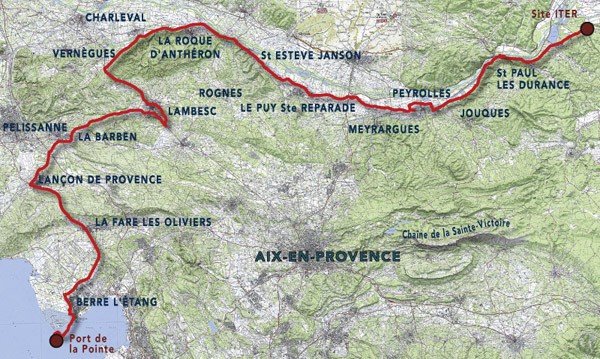ITER NEWSLINE
69
A long and winding road
Sabina Griffith
"Where there's a will, there's a way," as the proverb goes. The long and indeed winding road on which the biggest components of the ITER machine will travel is making good progress. The ITER Itinerary spans 106 kilometres from the port in Fos-sur-Mer to the construction site in Cadarache. Along its length, roundabouts have been "cut in half and flattened" to allow the special convoys to cross; electricity and telephone pylons have been moved; and bridges have been reinforced or rebuilt for the heavy cargo. The large flatbed transport vehicles which will carry the machine components will only accept curves in the road of less than 10 cm.
The ITER construction site is not exactly situated next to the sea. Finding a feasible solution to get the ITER coils and the vessel to the construction site without scratches or bruises posed some challenges to the logistics team involved in the site studies back in 2001. "We investigated every possible option," explains Akko Maas, a member of the ITER Project Office and part of the site study team at that time. "We investigated transport by helicopter or zeppelin, even a hovercraft along the Durance River was examined."
About 200 very exceptional convoys will travel the ITER Itinerary over the first five years of the construction phase, bypassing 16 villages and crossing two motorways (A7 and A51). Sixteen roundabouts and 24 bridges have been modified to receive the exceptional size and weight of some of the components. The nine parts of the vacuum vessel, for example, or the nineteen toroidal field coils are among the 200 components with an individual weight (including the transport vehicle) of up to 850 tonnes, and a total width of 9 metres. Once loaded onto special flatbed transporters, these components will travel by night at slow speeds in order to minimize disturbance.
Roadwork along the ITER Itinerary is under the responsibility of France, whereas the transportation of components between Fos and Cadarache will be financed by Europe. Work is closely followed by the ITER Transport Itinerary Coordination Group (ITICG), chaired by Akko, with participation from ITER, the European Domestic Agency, Agence Iter France and Mission ITER.
return to Newsline #69




